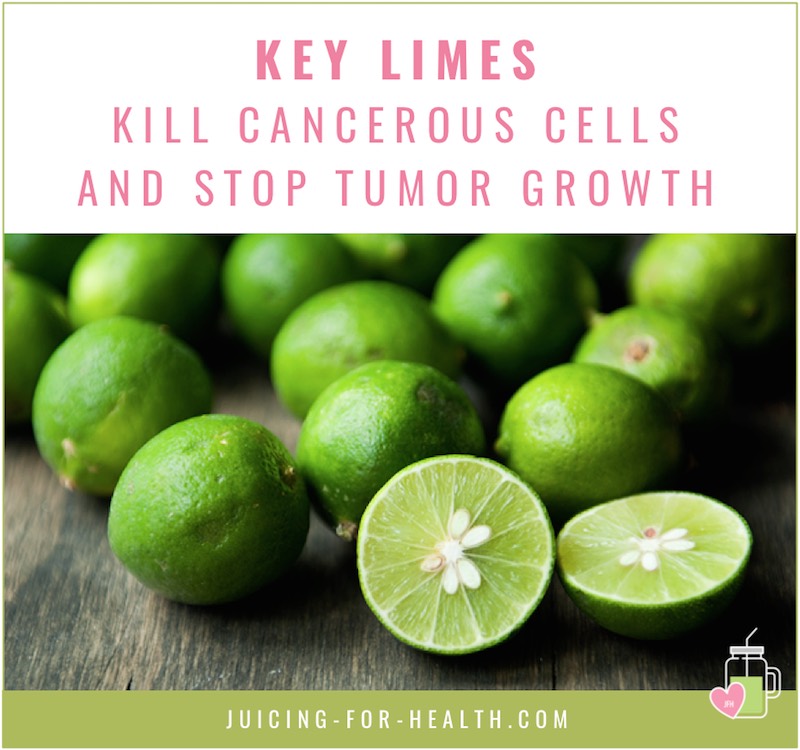Key Limes Kill Cancer Cells And STOP Tumor Growth In Their Tracks!
Last updated on
Key lime (a.k.a. Mexican or West Indian limes) is a citrus hybrid (micrantha x citrus medica) of about 2.5 to 5 cm (1 to 2 in) in diameter. Compared to the Persian lime, it is smaller and seedier, has a higher acidity, stronger aroma and thinner rind.
Also known as bartender’s lime, this hybrid fruit is often used by bartenders in mixing drinks.
You may know it as the essential ingredient of the Key lime pie, a traditional American dessert, but did you know it has a ton of fabulous health benefits too?
For instance, one of them is that it apparently can help stop cancer!
What kind of cancer, you ask? MANY of them, actually!

How Key Limes Kill Cancer Cells And Stop Tumor Growth
Gastric cancer: Key lime is rich in nobiletin, a special flavonoid that’s abundant in citruses, and there are some studies indicating it is fairly effective against gastric cancer. To give you an idea of how effective citruses are in this matter, studies indicate that eating just 100 grams of citruses on a regular basis may decrease your risk of developing stomach cancer by about 40%.
Prostate cancer: Another flavonoid common for all citruses is naringenin, and it was confirmed to be effective against prostate cancer (mainly thanks to its ability to fix damaged DNA).
Liver cancer: A recent animal study discovered that the peel of Key limes has special polysaccharides (a type of carbohydrate) with anti-tumor action. Specifically, they helped immune cells get inside the tumor and kill it, stopped cancer cell division, and even induced cancer cell death. Naringenin (the flavonoid mentioned in the point about prostate cancer) is also somewhat effective against some types of liver cancer.
Breast cancer seems to be quite susceptible to the action of Key limes extract as well. Different studies indicate that Key lime juice extract significantly slows down the growth of breast cancer after 24-48 hours of action—and even kills some of the cancer cells along the way. Another study reported that Key lime extracts significantly increased the effectiveness of conventional chemotherapy drugs for breast cancer, at least against the MCF-7 breast cancer line.
Colon cancer: The active compounds (limonene and dihydrocarvone) found in the volatile oil of Key limes can inhibit colon cancer growth in 67–78% of cases after just 48-72 hours of action. Hesperetin, another active compound of Key lime, is also amazing against colon cancer.
Pancreatic cancer: The action of Key lime extracts doesn’t stop at 72 hours of exposure. Apparently, at 72-96 hours of action its active compounds can stop 73-89% of pancreatic cancer growth.
A quick note before we move on: please remember that these are all laboratory and animal studies. There’s still a lot to be studied here, like the specific recommended doses for humans and so on. Basically, we know that Key lime is most likely beneficial for the types of cancer mentioned above, but we can’t name the effective range for every condition yet.
Additional Health Benefits of Key Lime
Lowers blood glucose and cholesterol levels: The active compounds in Key lime leaf essential oil (limonene, neral, linalool) were confirmed to have blood glucose-lowering and blood-cholesterol lowering effects.
May help in controlling body weight and reducing cardiovascular risk: A 2016 study on teenagers with excess weight revealed that a Key lime peel extract taken daily for 4 weeks helped the teenagers to lose some weight and slightly decreased their blood pressure. The beneficial effect on the blood pressure is most likely based on the extract’s ability to calm down the heart and relax the blood vessels, so it’s a 2-in-1 effect. Quite reliable.
Inhibits the growth of insanely drug-resistant bacteria: A bacterium known as Helicobacter pylori (H.pylori) is believed to be the primary cause of bacterial gastritis (type B) and the vast majority of peptic ulcers. The conventional way of getting rid of this germ is through specific antibiotics, but sometimes even they aren’t enough. Well, last year a study confirmed that Key lime can inhibit the growth of triple-resistant Helicobacter!
May protect the bone marrow, kidneys and liver from heavy metal toxicity: Thanks to its high content of flavonoids and vitamin C, Key lime juice has been found to significantly support the function of the bone marrow, liver and kidneys in animal models of lead toxicity.
Has anti-inflammatory properties: Another animal study has found that the active compounds in Key lime extracts have moderate pain-killing and anti-inflammatory properties. The researches noted, however, that the safety of Key lime extracts has to be studied thoroughly because its aromatic compound citral can have a detrimental effect on bone marrow at high doses.
Wide-range antibacterial properties: Several studies have reported that Key lime extracts effectively fight a wide range of gram-positive, gram-negative, and anaerobic bacteria even when applied topically.
Can be used as an extremely effective natural mouth rinse: In 2015, a study reported that a combination of garlic and Key lime for a natural mouth rinse is effective against the most common mouth bacteria and fungi, meaning it could protect you from dental plaque and cavities.
How To Consume Key Limes For Their Anticancer Benefits
Both the skin and juice of Key lime can be used.
If you want to maximize its cancer-fighting benefits, forget eating Key lime pies. Aim for a half-cup of fresh lime juice a day. Avoid drinking undiluted juice to protect your teeth, or use a straw.

Here’s a simple recipe. Clean these and put them through your slow juicer. If consuming as part of a cancer diet, always use organic only.
- 4-5 Key limes (with peel — this greatly increases the anticancer potency)
- about an inch-cubed size of ginger root
Add 2 cups of cold water and warmed raw honey to sweeten as desired.
You can also take advantage of the intense concentration of antioxidants in the fruit’s skin by zesting. The zest of Key lime is perfect as a garnish on salads, a flavor-booster for drinks, or as a salt alternative when sprinkled on your food.
Conclusion
Keep in mind that most of the available research we have on the active compounds of Key lime and the specific effects of Key lime extracts for the treatment of different conditions is fairly new.
So, it will take quite some time before clear recommendations can be given on the matter, but the amazing potential of Key lime is already undeniable—and exciting!
Quite a few reasons to make Key lime your favorite citrus, right? 🙂
Some of the links I post on this site are affiliate links. If you go through them to make a purchase, I will earn a small commission (at no additional cost to you). However, note that I’m recommending these products because of their quality and that I have good experience using them, not because of the commission to be made.
Comments
Leave a Reply









































 JOIN OVER
JOIN OVER
Greetings. Would you be kind enough to answer a few questions that i have. It would be greatly apricated.
Questions:
(1) Is Key lime acid or alkaline? I have read different reports and one report says it is acid but once ingested it become alkaline. Which is correct.
(2) Our daughter who just turned 22 years of age her immune system is very weak. What can you suggest that will help improve her immune system and strengthen it?
Thanking you in advance for your assistance and knowledge. God Bless.